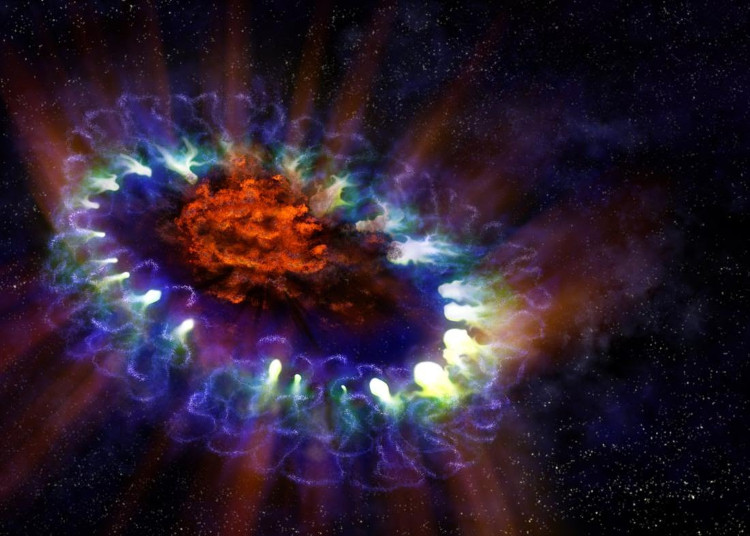Build 3D core map of a supernova
Astronomers have just observed the supernova core SN 1987A and discovered previously undiscovered molecules in any explosion.
More than three decades ago, astronomers witnessed a rare and extremely intense cosmic event: a dying star that exploded 168,000 light-years away, radiating brightness 100 million times the Sun.
That explosion was later known as Supernova 1987A, it was so bright that it became the only supernova observed with the naked eye after nearly 400 years. And now scientists are looking deep into the heart of the explosion and building a detailed 3D map of it.

Simulate a new superstar explosion.(Photo: A. Angelich; NRAO / AUI / NSF).
Using the Great Telescope Chain at Atacama (ALMA), the researchers analyzed and built up a 3D map of the structure of molecules formed from the remnants of supernovae, and discovered that there were feces new chemical element that has never been discovered before in the explosion.
'When the explosion happened 30 years ago, astronomers had little knowledge about explosions like this. They do not know how it affects the surrounding space, as well as the sudden cooling of the hot matter of the star that can create new molecules , 'said astronomer Remy Indebetouw of the University of Virginia. know.
'From observing from ALMA, we finally saw that the cold star dust formed from the explosion, gives us an understanding of the star's self and how a new superstar explosion was formed.' , he added.
Although supernovae look like vandals, the death of a star threatens any celestial bodies in the surrounding space, but they also create chemical reactions that produce dust. the universe, is the first step to creating planets.
Indebetouw's team used observations by ALMA to monitor the core of SN 1987A at millimeter wavelengths - the interval between infrared and radio - resulting in an unprecedented view of the core of a The star is booming.
With this result, they were able to map 3D structures of the supernova , showing the location and abundance of new molecules formed within it, including silicon monoxide (SiO) and carbon monoxide. (CO).
In another independent study, the researchers relied on observations of ALMA to see previously undiscovered molecules in supernovae, including formyl cation (HCO +) and sulfur monoxide (SO ) .
'This is the first time we have found these molecules in a supernova explosion, helping to answer a long-standing question, that a star explosion has destroyed all the molecules inside the throne. Why is that or not? ' said Mikako Matsuura of Cardiff University in England.
According to the researchers, the findings of these new molecules hypothesize that there will be many more molecules in the supernova core that have not been found, thus showing the intensity of stellar explosions such as how.
- Core Earth originated from supernova?
- Earth used to catch supernova dust
- Mysterious 2,000-year-old supernova
- Discover new forms of supernovae
- Can the planet exist between the Milky Way core?
- Discover one more layer of the earth's core
- Learn about supernovae and supernovae
- Discover new supernova
- Photos, videos and three-dimensional models of giant supernova
- Create supernova explosions in the laboratory
- The supernova explosion is 10.5 billion light-years away from Earth
- The supernova is 20 times brighter than the Milky Way
 Van Allen's belt and evidence that the Apollo 11 mission to the Moon was myth
Van Allen's belt and evidence that the Apollo 11 mission to the Moon was myth The levels of civilization in the universe (Kardashev scale)
The levels of civilization in the universe (Kardashev scale) Today Mars, the sun and the Earth are aligned
Today Mars, the sun and the Earth are aligned The Amazon owner announced a secret plan to build a space base for thousands of people
The Amazon owner announced a secret plan to build a space base for thousands of people Extraterrestrial Object 12,800 Years Ago Changed Humanity
Extraterrestrial Object 12,800 Years Ago Changed Humanity  The mystery of the Tunguska explosion may have been solved, the real cause was a drifting meteorite phenomenon
The mystery of the Tunguska explosion may have been solved, the real cause was a drifting meteorite phenomenon  Can cars really explode after a collision like in the movies?
Can cars really explode after a collision like in the movies?  3 natural disasters have not found the exact cause
3 natural disasters have not found the exact cause  Mystery of the biggest explosion in history, is it a message from space?
Mystery of the biggest explosion in history, is it a message from space?  Discover a new kind of explosion in the universe
Discover a new kind of explosion in the universe 